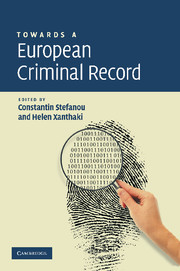1 - Introduction: How did the idea of a European Criminal Record come about?
Published online by Cambridge University Press: 13 July 2009
Summary
The necessity of a European Criminal Records: gaps in national criminal records
The concept of a European Criminal Record (ECR) was put forward to the Commission by Dr Constantin Stefanou, serving as the political reviser and horizontal expert in the study on the use of criminal records as a means of preventing organised crime in the areas of money laundering and public procurement funded by the Commission as a Falcone study in 1999. Over a period of two years a multidisciplinary group of fifteen national and three horizontal/comparative experts joined forces to examine and comparatively evaluate the laws on national criminal records in the then fifteen Member States of the European Union (EU) as a means of assessing whether national criminal records are effective and adequate solutions to the problem of increased mobility of persons, services and, consequently, crime in the EU. This multinational, multidisciplinary research revealed that all older Member States maintain databases of convictions imposed on own nationals by national judicial and, at times, administrative authorities; however, the use of national criminal records for the purposes of adhering to the money laundering and public procurement provisions envisaged by the EU in the relevant Directives is not undertaken in a number of countries, including Spain and Sweden. More crucially, the study reveals discrepancies in national criminal records with reference to three main points: the level of information available in the records, the types of persons with entries in national criminal records and the ground covered in these records.
- Type
- Chapter
- Information
- Towards a European Criminal Record , pp. 1 - 24Publisher: Cambridge University PressPrint publication year: 2008



